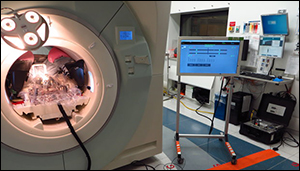Inside an MRI, a Non-Metallic Robot Performs Prostate Surgery
13. 7. 2015 | IEEE Spectrum | spectrum.ieee.org
One of the holy grails of robotic surgery is the ability to perform minimally invasive procedures guided by real-time scans from a magnetic resonance imaging, or MRI, machine.
The problem is the space inside MRI scanners is tight for a person, let alone a person and a robot. What’s more, these machines use very strong magnetic fields, so metal is not a good thing to place inside of them, a restriction that is certainly a problem for robots.

Now researchers at Worcester Polytechnic Institute (WPI) are developing a MRI-compatible robotic surgery tool that can overcome those limitations. Their system isn’t made of metal, but instead has plastic parts and ceramic piezoelectric motors that allow it to work safely inside an MRI. The tool is now being tested on human patients undergoing prostate biopsies at Boston’s Brigham and Women’s Hospital. The radiologists can use real-time MRI images to guide the movement of their robotic assistant, which they believe will provide unprecedented accuracy.
The robot, developed by WPI in collaboration with Brigham and Johns Hopkins University, also boasts a low-noise control system that doesn’t cause electrical interference. “Essentially, we made a device that can move around the MRI bore without affecting image quality,” says Gregory Fischer, a professor of mechanical engineering at WPI whose Automation and Interventional Medicine Robotics Lab led the research.
Read more at IEEE Spectrum
Image Credit: WPI
-jk-




